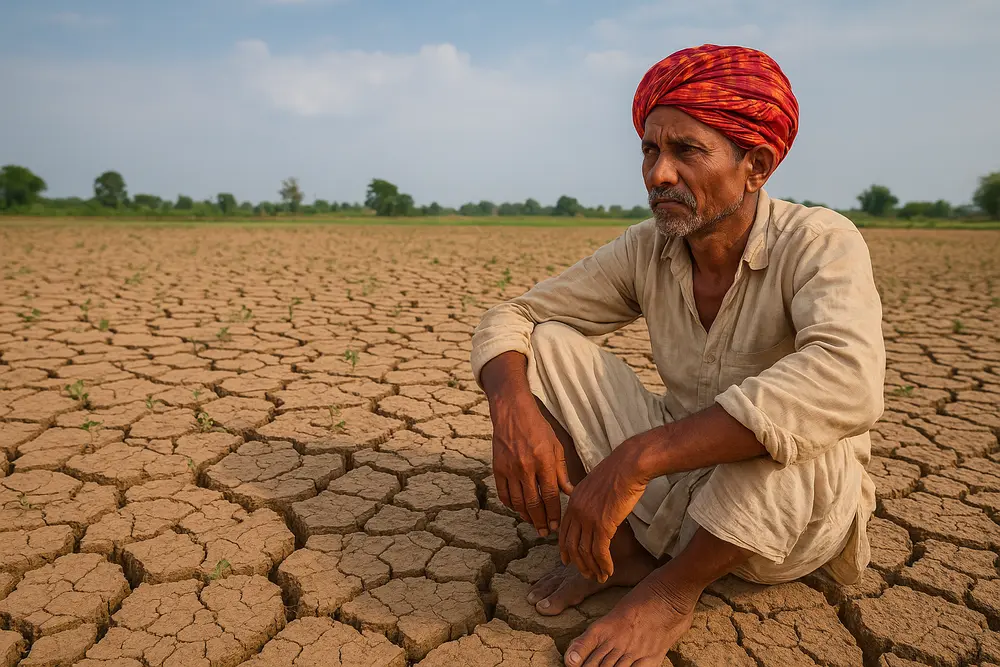Water Scarcity in India: A Growing Threat to Agricultural Sustainability
Imagine a farmer standing in his parched field, staring at cracked soil that once produced healthy crops. This is not just a scene from a drought-stricken village—it’s becoming an everyday reality across India.
With nearly 70% of rural households depending on agriculture for their livelihood, water scarcity has turned into one of the biggest challenges for India’s food security and rural economy.
India holds 18% of the world’s population but only 4% of its freshwater resources. Add to this the pressure of climate change, over-extraction of groundwater, and inefficient irrigation practices, and the picture becomes alarming. Farmers who once relied on predictable monsoons now face erratic rainfall, dry wells, and mounting losses.
But water scarcity is more than just a farming issue—it’s a human issue. It shapes livelihoods, drives migration, increases debt, and even impacts mental health. And if left unchecked, it could put India’s dream of agricultural sustainability and food self-sufficiency at serious risk.
Discover how water scarcity impacts Indian farmers—reducing crop yields, increasing debt, driving migration, and threatening agricultural sustainability.

The Consequences of Water Scarcity on Indian Farmers
Water scarcity in India isn’t just a looming crisis—it’s here, and it’s affecting millions of farmers across the country. Simply put, water scarcity is a shortage that makes it hard for farmers to grow enough crops. That might sound straightforward, but the ripple effects are incredibly complex.
India is home to 18% of the world’s population but has only 4% of the planet’s freshwater—that’s an imbalance that has serious consequences.
Recently, a 2024 report warned that by 2050, 50% of Indian districts could face “severe” water scarcity. And even today, millions are already dealing with high to extreme water stress.
Indian farmers rely heavily on water—not just from the sky, but from underground too. Around 70% to 80% of Indian farmers depend on groundwater for irrigation.
In Punjab, Haryana, and Rajasthan, a shockingly large number of groundwater blocks are overexploited or critical.
In this article, we’ll walk through why water scarcity matters, how it hits farmers so hard, and what hopeful solutions are emerging. We’ll keep it easy, empathetic, and rooted in real-life needs.
Understanding Water Scarcity in India
First things first: what is water scarcity? It simply means there’s not enough accessible water for everyone to use. In India, the shortage is driven by several factors:
- Population pressure and rapid urbanization have put immense pressure on limited water resources.
- Overuse of agricultural water is a huge issue—agriculture uses 80–90% of India’s water; surface irrigation efficiency hovers around just 38%.
- Groundwater depletion is rampant—India extracts nearly 25% of the world’s groundwater. Many regions like Punjab, Haryana, and Rajasthan have dangerously low groundwater levels.
- Climate change disrupts seasonal rainfall patterns. Predictions show per capita water availability dropping further—from ~1,434 m³ by 2025 to only 1,219 m³ by 2050.
- Inefficient irrigation—traditional flood irrigation wastes a lot of water compared to modern techniques like drip or sprinkler systems.
In short, water scarcity in India is not a distant worry—it’s a current reality shaped by demand, misuse, and changing climate.
The Impact of Water Shortage on Indian Farmers
Water scarcity in India deeply affects farmers, reducing crop yields, increasing debt, driving migration, and harming mental health. Its consequences go beyond economics, reshaping rural communities and threatening agricultural sustainability.
Water scarcity hits farmers hard across multiple fronts:
Economic Strain
Crop failures become more frequent when water runs out. Irrigation gaps mean lower yields and big financial losses.
Rising indebtedness—when crops fail, farmers borrow more, only to face bigger losses later. Some regions report cycles of debt that leave families struggling.
Social Disruption
Forced migration becomes common as farmers leave parched fields in search of work in cities.
Land distress occurs when families must sell or abandon land to survive—a heartbreaking reality.
Declining Agricultural Productivity
Water stress means lower yields and sometimes even abandoning water-intensive crops like rice and sugarcane. These crops dominate agricultural output.
Monsoon failures play havoc with rain-fed areas, especially where only 60% of net sown area gets irrigation.
Mental Health Toll
The uncertainty, financial burden, and loss of identity tied to a farmer’s land lead to immense mental strain—stress, anxiety, and loss of hope.
State-Specific Examples
In Punjab, groundwater is depleting so fast that current use exceeds recharge—experts fear aquifers might collapse before 2040.
Rajasthan has seen limited adoption of micro-irrigation—less than 10% of farms use it—despite its potential. Rainwater harvesting efforts are present, but over a lakh (100,000) farmers applied for farm ponds, and only 20,000 could get support.
UP (Uttar Pradesh) has reallocated 85% of MNREGS Natural Resource Management budget to water conservation—ponds, rain harvesting, and soil moisture projects—boosting both water security and livelihood resilience.
Every day, these water shortages bulldoze through communities that built their lives around the land.
Regional Variations in Water Scarcity
Water scarcity doesn’t look the same everywhere in India. Here’s a breakdown by region:
Maharashtra (Marathwada and Vidarbha)
Recently, dam storage is up—88.6% full, up from 76.7% last year—thanks to monsoon rains. But in Nagpur/Vidarbha, it’s lower at 70.9%. Tragically, flash floods also washed away crops on 14 lakh hectares.
In Marathwada, flooding killed 11 people, destroyed 3.58 lakh hectares of farmland across some 1,154 villages—damages beyond financial loss.
Andhra Pradesh (North Coastal)
Dry conditions earlier in the season threatened paddy and sugarcane. But recent rain brought hope, even though irrigation infrastructure remains weak.
Central India (Madhya Pradesh—Indore region)
Rainfall is still below normal—37% below in some areas like Indore—but ongoing showers may help narrow the gap soon.
Punjab & Haryana
These states lead in over-exploited groundwater zones. Over 78% of blocks in Punjab, and many in Haryana, are under extreme stress despite rainwater conservation campaigns like ‘Catch the Rain’.
Every region has its own struggle—from floods to droughts, from depleted aquifers to overwhelmed dams.
Government Policies and Initiatives
The government has launched several programs to tackle water scarcity:
PMKSY (Per Drop, More Crop)
Pradhan Mantri Krishi Sinchayee Yojana (PMKSY) promotes drip and sprinkler irrigation to enhance water efficiency. But uptake remains limited in vast parts of the country.
Jal Jeevan Mission (Har Ghar Jal)
Jal Jeevan Mission aims to provide 55 liters of tap water per rural person per day by 2024. Though focused on drinking water, it eases pressure on farmers and rural communities.
Jal Shakti Abhiyan – ‘Catch the Rain’
Jal Shakti Abhiyan – ‘Catch the Rain’ (JSACTR )is a nationwide water conservation campaign launched by the Ministry of Jal Shakti, India. Its core message is: “Catch the rain, where it falls, when it falls.” The initiative targets water conservation through rain harvesting. Punjab and Haryana are major focus zones, with 148 districts in 2025 targeted for action.
MNREGS with water focus
In UP, the Mahatma Gandhi National Rural Employment Guarantee Scheme (MGNREGS), or MGNREGA now dedicates over 85% of its NRM funds to water conservation—retaining soil moisture, building ponds, boosting climate resilience.
Climate-Resilient Seeds
India introduced 109 climate-resilient seed varieties, with a goal to plant 25% of paddy land with them. Distribution and support remain key challenges.
Overall, these programs show intent—but challenges persist in reach, funding, and follow-through.
Adaptation and Sustainable Solutions: Pathways to Water-Smart Farming
As water scarcity deepens, Indian farmers are turning to innovative practices, traditional wisdom, and modern technologies. These adaptive solutions offer sustainable ways to save water, boost productivity, and secure farming livelihoods for the future.
Hope is alive in innovation and traditional wisdom:
Micro-Irrigation & Efficient Farming
Adoption of drip/sprinkler irrigation covers only 19% of irrigated land, though it can drastically save water.
Techniques like Alternate Wetting and Drying (AWD) for rice reduce water use without sacrificing yield.
Innovations like Zeba, a biodegradable water-absorbent, boost water use efficiency by 15–20% for crops like sugarcane.
Subsurface drip and zero tillage, along with laser-leveling, further cut water waste.
Harvesting and Local Wisdom
Structures like Amrit Sarovars restore local water bodies and support farming.
Traditional systems like Rüza (Zabo) in Nagaland use gravity-driven rainwater ponds to irrigate terraced fields—and integrate rice, fish, horticulture—all sustainably.
In Bundelkhand, women’s groups called Jal Sahelis revived lost water bodies across 200 villages—turning water scarcity into community-led resurgence.
In Ladakh, Ice Stupas serve as artificial glaciers—melting in spring to irrigate otherwise dry land.
Technology & Climate-Smart Farming
IoT-based soil moisture sensors and mobile alerts help farmers use only what’s needed.
In Punjab, IoT farming cooperatives use sensor alerts to optimize water use in wheat/paddy.
AI tools for weather forecasting helped smallholder farmers reduce debt and increase savings—presenting a strong direction for scaling.
Private Sector & Community Collaboration
Private partnerships (e.g., Jain Irrigation, UPL, ADI, PRADAN) have supported technology, farmer groups, and water projects that yield both good crops and better livelihoods.
These combined efforts—modern and traditional, technological and community-based—paint a hopeful picture for a waterwise India.
The Human Story: Voices from the Ground
Behind statistics are real farmers—men and women whose daily struggles and resilience show the true human cost of India’s water scarcity crisis.
Let’s hear from real people affected by this crisis:
1. Kahan Singh Pannu (Punjab): An IAS officer turned farmer, he developed the SRB method (Seeding of Rice on Beds)—which uses just 20–25% of the water needed for traditional paddy farming. He’s scaling this across Punjab with custom machines—an inspiring blend of innovation and empathy.
2. Bundelkhand’s Jal Sahelis: Women, many without formal education, are recharging ponds, protecting water sources, and reviving agriculture in nearly 200 villages. Their leadership made thirsty land green again, proving that change can begin from the grassroots.
3. A farmer in Rayanpet (AP): Struggling with erratic rains, he welcomed climate-resilient seeds released by the government. These require less water and resist disease—but affordability and proper training remain hurdles.
Through their stories, we see that water scarcity is more than a statistic—it’s a lived experience of struggle, resilience, and innovation.
Future Outlook and Recommendations: Securing India’s Farmers Against Water Scarcity
India’s water crisis is deepening, and if urgent measures are not taken, the future for millions of farmers could be at risk. Reports warn that by 2050, nearly half of India’s districts may face severe water scarcity, threatening food security and rural livelihoods. However, this future is not inevitable. With the right policies, technologies, and community-led initiatives, India can secure its agricultural backbone.
Building Climate-Resilient Agriculture
The first step is adopting climate-resilient farming practices. This means expanding drought-tolerant seeds, promoting crop diversification toward millets and pulses, and moving away from water-guzzling crops like paddy and sugarcane. A resilient cropping system will reduce water stress and provide farmers with more stable incomes.
Scaling Efficient Irrigation
India must accelerate the adoption of micro-irrigation systems like drip and sprinkler methods. Currently, only about 19% of irrigated land uses such systems. Wider adoption could save billions of liters of water annually while increasing yields. Programs like “Per Drop, More Crop” should be better funded and monitored for effective results.
Strengthening Community and Policy Action
Government programs such as Jal Jeevan Mission and Jal Shakti Abhiyan are important, but they need stronger local participation. Grassroots movements like Jal Sahelis in Bundelkhand show how community-led initiatives can revive water bodies and empower farmers. Expanding such models nationally could build resilience at scale.
Leveraging Technology and Innovation
Technology will be a game-changer. AI-driven weather forecasting, IoT-based soil sensors, and mobile advisory services can help farmers make informed water-use decisions. Partnerships with private companies and NGOs can accelerate innovation and accessibility.
A Collective Responsibility
The path forward requires collaboration—government, private sector, scientists, and farmers must work together. If India invests today in sustainable water management, it can ensure not only food security but also the future of its farmers.
Read Here: The Impact of Climate Migration on Social Structures
Conclusion
Water scarcity in India is not just a future worry—it’s reshaping lives, livelihoods, and landscapes today. Farmers bear the brunt: from failed crops and mounting debts to migration and emotional distress.
Yet, in the midst of this crisis, there’s hope. Communities, governments, and innovators are stepping up—whether through smart irrigation, traditional methods like Ice Stupas and Rüzas, or community-driven models like Jal Sahelis.
But we need more of this—and faster. If policymakers, researchers, the private sector, and farmers unite around sustainable, scalable solutions, we can protect precious water, secure rural livelihoods, and nurture agricultural resilience.
Let’s act now—not just with plans, but with people-first solutions—to ensure that India’s farmers have water, security, and hope for generations to come.





